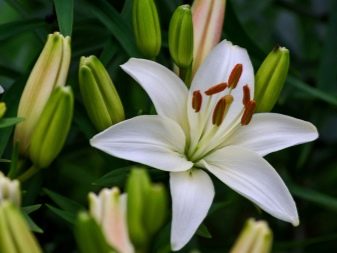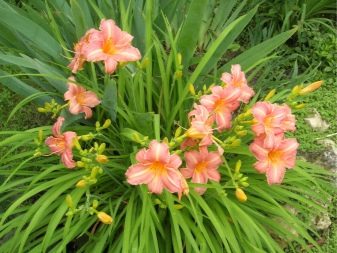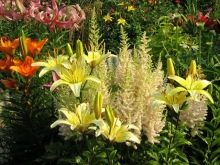What to plant next to lilies?

"Lily is the second after the rose", there is such a saying in the world of flower growers. In the garden, indeed, lilies look graceful, very beautiful, and those who are ready to care, even to the whims of the plant, undertake to grow them. The decorative effect is worth it. But it happens, no matter how hard you try, but lilies do not grow well: perhaps the point is in the wrongly chosen neighbors.
Daylily compatibility
They grow well in groups, 5-6 samples together, then it looks as impressive as possible. Moreover, lilies can be of different colors. There is no need to be afraid of color mixing due to over-pollination. Compatibility lies in the combination of flowers of different shapes and sizes of inflorescences, with a few exceptions.
By the way, lilies and daylilies are different plants. Moreover, they are not even considered relatives. Lilies belong to the lily family, the bulbous type. Daylilies do not have a bulb underground, but a rhizome, and they belong to the Xantorrei. Therefore, the methods of reproduction in two consonant plants are fundamentally different.
And the external differences are obvious: the daylily grows as a bush, has many flat leaf plates that come from the root rosette.


The height of the bush is very small, about 30 cm, in large ones - up to a meter (but there are not very many of them). But the lily will grow as a single stem and on average grows up to one and a half meters, some varieties even up to three. And the leaves of the lily grow along the entire stem, in a spiral. Further, it is even more interesting: they bloom in different ways. Lilies will delight with flowering from July to August, and each flower will "last" a maximum of a week and a half. The buds of this culture open gradually, the lower ones go first. In daylilies, the flower will live for only one day (that's why it is called otherwise “Krasnodnay”). Since one flower is replaced by another, in general, the bush will bloom for 25 days.
What these cultures have in common is their choice of location. They grow equally well in well-lit areas. But in general, lilies will be much more capricious: they need fertile soil, regular feeding, regular watering. Daylily is not so whimsical - it takes root in soil with a deficiency of nutrients, calmly refers to a lack of water. Some growers call it "unkillable", and this is a very accurate characteristic. It is also frost-resistant, and lilies (like any bulbous) have to be sheltered in the cold.
It is in this difference, the exactingness of lilies and the unpretentiousness of daylilies, and lies the moment of determining their neighborhood. Can be planted if the soil will meet the requirements of lilies. But if she is impoverished, the daylily will live there, but the lily will not. Someone will think that the point is the suppression of one plant by another, but no, it's just that the growing conditions for flowers are different.
As for the decorative component, this neighborhood is ideal - some plants make others richer, brighter and more expressive.


Neighborhood lilies with a rose
There is an interesting historical comparison: a rose is a symbol of England, and a lily is a symbol of Medieval France. The states are divided by the English Channel, and the political interests of these countries very often did not coincide. Neighbors were in conflict, and more than once. But such a metaphor, no matter how beautiful it is, does not work in relation to real colors. Both roses and lilies prefer sunny places on the site, and even calm. Covering them with dry leaves for the winter is also the same requirement for the two crops, because they do not differ in frost resistance.
This means that the flowers may well coexist, there are no contradictions in their cultivation, it will be easy to take care of them, because they have equal requirements. But still, flower growers warn that the idea of the proximity of two cultures is not always successful. This time it's about decorative contradictions: both plants are considered the queens of the site. They don't want to complement, they want to dominate. And if you believe that “the best is the enemy of the good,” such a combination may indeed be redundant.
Why not:
- the rose is very accented, it requires an environment that emphasizes its beauty, and does not argue with it - the same can be said about the lily;
- the closer the color gamut of colors, the worse - the visual effect is such that the impressions are not summed up, but one crosses out the other;
- it is almost impossible to pick up neighbors for both colors - against the background of this duet everything will fade.
Only an experienced florist or a naturally talented visualizer will compose these flowers side by side so that they will decoratively support each other. You need to be very well versed in varieties, see the compatibility of shades, predict how they will grow and when to bloom. There is a hint: if you really want to plant these plants nearby, you need to choose dark lilies and light roses. The latter, against the background of tall lilies, will look advantageous, the combination can be successful. All other options are rather controversial.


Compatibility with other colors
There is a whole list of plants next to which a lily will very successfully exist on a flower bed. And not only from the point of view of biological equality, similar needs and care, but also because of decorative connectedness. That's what these plants are.
- Astilba. This is a perennial that can grow more than a meter, with beautiful, literally delicate foliage and bright panicles of flowers. These plants are equally demanding - they will not suppress each other, but will perfectly complement the color scheme.
- Phlox. Also, together with lilies, they look quite suitable. Phlox bloom with fragrant caps. When the lilies begin to bloom, their companions will distract attention from this. Therefore, the proximity to plants with other flowering periods is often beneficial.
- Delphinium. Another tall perennial that blooms in blue or deep blue. With white lilies, they will come into a pleasant contrast. And the delphinium will also protect the lily from the wind, which is undesirable for her. The leaves of this plant will also cover the drying lily stems after flowering.
- Host. The flower goes well with the hosts, and their rich, variegated shades look gorgeous where the landscape is depleted in flowers, faded and monotonous. Hosts change color in the fall, that is, they promise a flower show on the site with a change in color - this is always an interesting, spectacular step.
- Hydrangea. This combination also has every chance of success, because the shrub, featuring huge caps of small flowers, will be an excellent backdrop for a lily. And lilies of any color.
- Peonies. In the same flower garden with peonies, lilies look confident. It will not be such a controversial combination as with roses. Peonies bloom at a time when the lilies have not yet thought to bloom. Conversely, when the lily is in bloom, the peony has already faded. But its dark green leaves will be a chic backdrop for vibrant lilies.
- Pyrethrum. These are almost daisies, only small ones - they cannot compete with the lily, but are considered almost the only plants that set off the beauty of lilies, but do not themselves get lost against its background. Pastel salmon pyrethrum is especially good - very tender and warm.
- Yarrow. Hybrid varieties are impressive in their colors, so finding the shade that will perfectly match the lily will not be a problem.



But lily may not want to coexist with irises. First of all, they are similar in shape to the inflorescences, that is, they will be lost against the background of each other. And after the flowering of irises, you need to seriously reduce the watering regime, but at this time lilies will bloom, which need water.There is a close history with gladioli, they are too similar to each other, it is extremely difficult to combine them in one landing without drowning out a partner. But experiments are not ruled out.
Chrysanthemum is not the best neighbor, because asters and vernonia are ideal for her company. Lilies and tulips have many common diseases, therefore they are not planted next to them. Moreover, you should not plant lilies in the place where tulips grew. Daffodils are also bulbous, and somewhere, according to the requirements, they will have similarities, but together they do not look very expressive. Although the flowering periods are different, it is better for daffodils to choose other partners - even with tulips together they will look more spectacular.
This is not to say which option is better than others. If you want conceptuality, it is better to plant lilies of different varieties and colors next to each other - this combination can be accent, perhaps the main one on the site.
But it is better to select varieties so that when some flowering, other varieties enter the flowering period. Then the flower bed will not be bare in the middle of the season. Happy combinations!










































































































The comment was sent successfully.